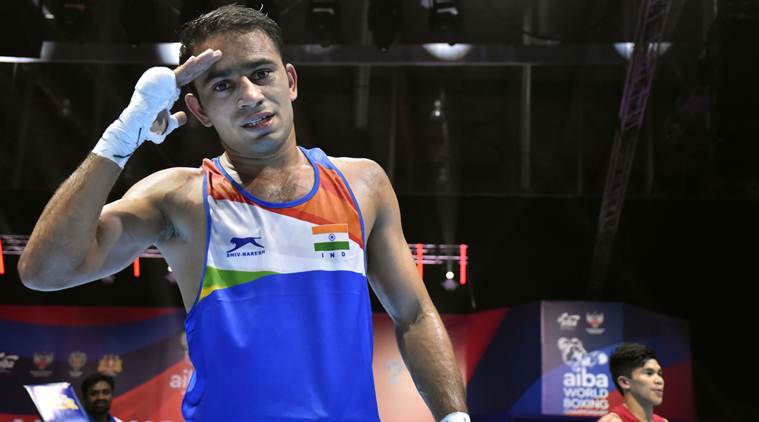Friday’s World Championship semifinal was tricky. Saken Bibossinov was three inches taller and preferred fighting from a distance. And the southpaw Kazakh was coming into the bout with a strong win over European gold-medallist Artur Hovhannisyan.
If you go by the coaching staff’s assessment, Amit Panghal is Sherlock Holmes come to life. In that the Indian boxer is not helping out redheads or chasing demonic hounds in the countryside. The reference is more to the version played by Robert Downey Jr. Or at least the scenes in which the master sleuth contemplates physical altercation, calibrating his opponent in a pre-fight walkthrough, figuring out where to hit, how hard to hit and what happens once he hits.
“Amit is like that only,” coach Jay Singh Patil tells The Indian Express from Ekaterinburg. “He is India’s most cunning boxer. So when people think he is starting slow or is nervous in the beginning, he is only figuring out the strategy of his opponent. Then in the two rounds he breaks them down.”
There is merit to not leaving a contest till too late (check our coverage of the Wrestling Worlds for more on that). But in Panghal’s case, it is all about belief in one’s abilities and the gameplan. Coupled with his technical prowess, the confidence makes him India’s best flyweight.
A slyweight, if you will.
Friday’s World Championship semifinal was tricky. Saken Bibossinov was three inches taller and preferred fighting from a distance. And the southpaw Kazakh was coming into the bout with a strong win over European gold-medallist Artur Hovhannisyan.
Pushing the pace
It started out in a typically cagey manner, but unlike Panghal’s previous opponents, especially the Filipino in the semifinal, Bibossinov was conservative. He took his time, feinted, gauged the distance and avoided long combinations. On several instances it was the Indian who tried to push the pace and was tested by counters. Panghal’s been dispatching opponents trying to rush by creating space and countering. Here was a guy who knew how to use the height and reach advantage, goading the Indian to make the moves.
“Nervousness to kuch nahi thi. Just that the Kazakh started out well, but I was confident in the strategy and the game-plan,” says Panghal. “We had studied his bouts and knew what his plan would be. I just took some time to understand what he was trying to do and then began my attacks.”
Panghal began the second round with lunging jabs, moving in with a strong right and following it with that trusty overhand left. A few of those stinging combos were enough for the Kazakh to start attacking, and playing into Panghal’s hands. The
“It took Amit two minutes to study the Kazakh boxer,” says high performance director Santiago Neiva. “We were always confident, even during the announcement of the decision In a close bout but in a fairly clear manner.”
Two judges had scored the bout against Panghal, a verdict too close for comfort.
“When they said ‘split’, my heart was in my mouth,” says chief coach CA Kuttappa. “The way he had played the second round, and then he completely outboxed the opponent in the third. There was no way he could have lost. And we were ready to protest had the decision gone against him.
But for Panghal, the outcome was rather elementary.
“I wasn’t nervous during the decision. I had a plan for him, and I followed it very well,” Panghal laughs. “Mujhe pata tha ye bout main aasaani se jeeta hun.”
Source: Read Full Article


